Using Apocalypse World to Outline and Draft Your Own RPG
Here in Part 3, I’m diving back into Apocalypse World’s basic moves. I’ll go through them one by one to talk about how and why they work the way they do.
This article was made possible by the generous support of my patrons. Please consider joining them by supporting me on Patreon.
Here’s What
Apocalypse World offers a powerful, flexible framework you can use to outline, draft, and potentially finish your own roleplaying games. Dozens of creators, both experienced designers and first-timers, have used it with great success, and you can too. It’s not a game system as such, it’s an approach to game system design. It’s easy, and it’s a reliable way to get your creative vision quickly into a playable form.
Reminder: The Goal is to Create a Playable Outline
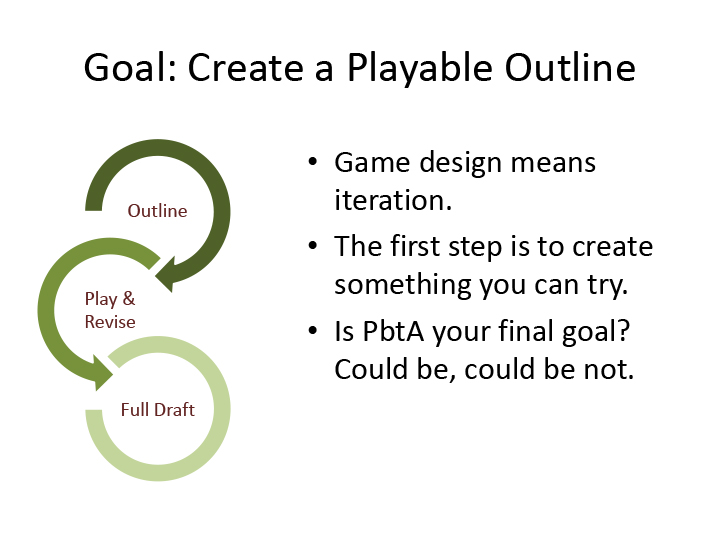
The process of game design for me is intensely iterative: a first stab, then play & revise, play & revise, play & revise. Eventually, after enough iterative cycles, I can make a full draft. Then comes more play and revision as I take the game public, and only once all of those cycles are done do I go on to finish the game for release.
So this series is about only that first goal: to make something you can try. The rest of the process, the vast bulk of the process, we’ll have to take up another time.
I want to emphasize and re-emphasize: maybe, at the end of the iterative process, you have a PbtA game, or maybe you set PbtA aside somewhere along the way and come out with something else altogether. That’s FANTASTIC.
My goal is to get you into the iterative cycle. Whatever comes out of it, is up to you.
Apocalypse World’s Basic Moves

Apocalypse World has 10 basic moves. They are, in order by stat:
- Act under fire (Cool);
- Go aggro on someone (Hard);
- Seize something by force (Hard, “the basic battle move”)
- Sucker someone (Hard);
- Seduce or manipulate someone (Hot);
- Help or interfere (Hx);
- Read a person (Sharp);
- Read a situation (Sharp);
- Open your brain to the world’s psychic maelstrom (Weird);
- End the session (no stat).
Last time, in Part 2, I said that t he stats represent qualities that all the characters share, that we can use to compare them, and the basic moves are how the characters express them. This means that in the world of Apocalypse World, you show that you’re cool by acting under fire, you show that you’re hard by going aggro on people, seizing things by force, and suckering people, and so on.
I also said that the basic moves give structure and a certain order to the players’ conversations: who asks questions and who answers them, what you should say yourself and how you should treat the things that the other players say. I called it “permission and expectations.”
To say my next thing about the basic moves, though, I need to take you back to 2007 and my game Poison’d.
Attn: You Don’t Need to Read or Play Poison’d
Poison’d was one of my three games about Christianity, and, like the other two, it was hateful and unpleasant. It was about pirates, and they were ambitious, cruel, bloodthirsty, and wicked. The game offered neither mercy nor grace, except as a failure of justice.
It’s old. It’s hard to GM. I don’t recommend it!
I’m going to use it as an example here because it’s really plain and clear as an illustration, not because it’s especially good. I’m also going to tell you everything you need to know about it, so seriously, you don’t need to read it at all.
Thanks!
How Poison’d Worked
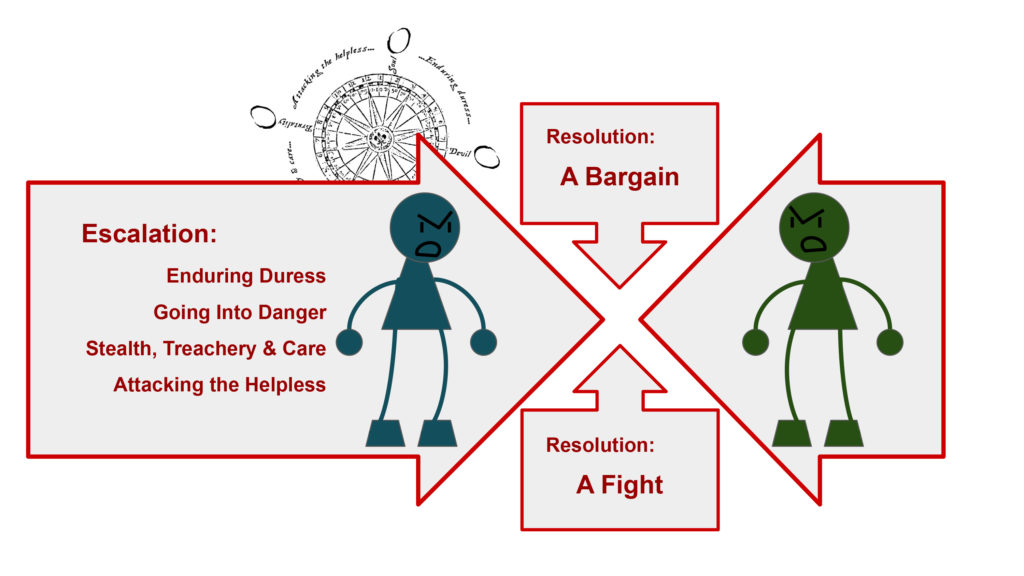
When your pirate character’s ambition or self-interest was incompatible with another character’s ambitions or best interests, the game held them to be in a state of implicit conflict. The game took the position that, given time enough and nothing else interfering, and given that the characters had means to pursue their interests, they’d have to resolve their conflict eventually, either by fighting or by making a bargain about it.
(As you might suppose, since all the pirates were ambitious, bloodthirsty, and avaricious, implicit conflict was ubiquitous in the game.)
Meanwhile, though, before the inevitable bargain or fight, it was often to your advantage to escalate the conflict between you. The game offered four different ways to escalate conflicts, which it called “success rolls”: enduring duress; going into danger; using stealth, treachery, and care; or attacking the helpless. Each character was better at some of these rolls and worse at others, depending on their attributes.
For example, if my pirate, captain of The Dagger, decided to pursue and seize a merchant ship, I might first use stealth, treachery and care to disguise The Dagger as a ship in distress, luring my prize close; and then when they came close, I could spring the trap and attack the helpless to launch the fight. Making the success rolls would let me fight on my own terms, with both an in-game and mechanical advantage. It might even put me in such a strong position that my prize’s captain would surrender without a fight, and we’d resolve the conflict with a bargain instead. For instance, maybe we’d strike a bargain that my pirate would plunder their ship and put the crew to sea in a lifeboat with a little food and water, instead of butchering them to the last soul.
Arenas of Conflict in Poison’d
So these success rolls. They were ways to escalate, paths toward the fight or the bargain, means to pursue your interests, modes of aggression to which your character was suited or unsuited. Let’s call them, encompassing all of those ideas, “arenas of conflict.”
Thus you might say that in Poison’d there were 6 arenas of conflict:
- Enduring duress;
- Going into danger;
- Using stealth, treachery, and care;
- Attacking the helpless;
- Bargaining; and
- Fighting.
How Apocalypse World’s Basic Moves Work
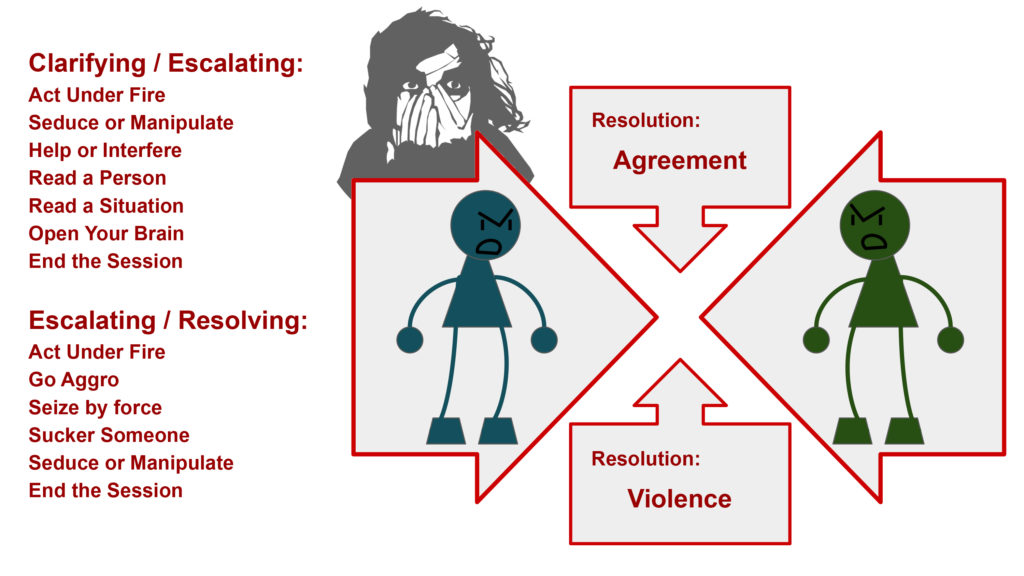
Apocalypse World is based on a model of implicit conflict similar to Poison’d’s. When your character’s vision, best interests, or survival instinct is at odds with someone else’s, the game takes the position that, with time, and given that both you and they have the means to pursue your interests, you’ll come into conflict and ultimately have to resolve it. You’ll resolve it either by setting the conflict aside and coming to an agreement, or by coming to violence instead.
Apocalypse World elaborates this model of implicit conflict into a much more complex system than Poison’d’s, though.
To begin with, Apocalypse World adds the process of clarifying conflicts to the existing processes of escalating and resolving them. In Poison’d, you have an explicit list of your pirate’s ambitions to drive you, and your enemies’ interests are similarly plain, so the matter of conflicts is rarely unclear. In Apocalypse World, though, you often find your character in situations that you don’t understand, with enemies and potential enemies whose interests aren’t obvious. The game needs systems for figuring out what the conflicts are.
And then, Apocalypse World breaks from Poison’d by having basic moves that don’t align 1-to-1 with the arenas of conflict, like success rolls did, but instead cross them, apply in different ways at the different stages of conflict and in the different arenas.
The graphic above shows what I mean:
- You can act under fire to help clarify some conflicts, as an escalatory move in conflicts you’re actively pursuing, and as a component of both coming to agreement (especially between PCs, via seduce or manipulate) or coming to resolve violence.
- You can go aggro on someone, seize something by force, or sucker someone to bring violence or the threat of violence directly to bear on the conflict between you, either as a move to escalate it or as a move to finally resolve it.
- You can seduce or manipulate someone to clarify a conflict by forcing them to commit to a side, to escalate a conflict by enlisting them as an ally, or to resolve a conflict by forcing an agreement upon them.
- You can help or interfere with someone to clarify your own position in a conflict, to take a side in a conflict they’re escalating, or to escalate a conflict between you.
- You can read a person or read a situation to clarify the conflicts between you or implicit in the situation, with a straight-up Q&A about them.
- You can open your brain to the world’s psychic maelstrom, similarly, to clarify the conflicts in play, with a farther-reaching scope and a different form of clarity.
- And when the session ends, reflecting on your interactions with the other characters and deciding who knows you better, and learning who you know better, can clarify or escalate the conflicts between you as well.
So much for the stages of conflict, clarifying, escalating, and resolving them. What about the arenas of conflict?
Arenas of Conflict in Apocalypse World
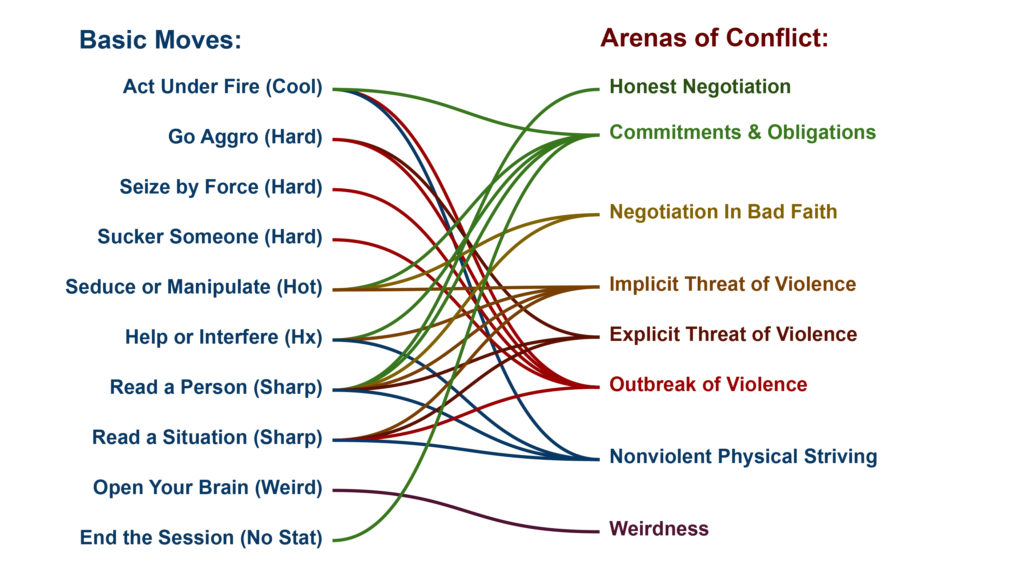
Poison’d had 6 arenas of conflict, named explicitly by the systems associated with them: enduring duress; going into danger; using stealth, treachery and care; attacking the helpless; bargaining; and fighting.
Apocalypse World has 8 basic arenas of conflict, not named explicitly by the text, but emergent from the basic moves’ interactions:
- Honest Negotiations. The only basic move available to you for honest negotiation is reading a person. If you bring any of the other interpersonal moves to bear, you compromise the good faith of your negotiation.
- Commitments & Obligations. Holding someone to their commitments isn’t bad faith, but it does create an imbalance between you. You can clarify, escalate, and resolve conflicts of commitment and obligation by acting under fire, seducing or manipulating someone, helping or interfering with them, reading them, or at the end of the session.
- Negotiation in Bad Faith. To lie, manipulate, or use someone, you might seduce or manipulate them or just read them and make your approach accordingly.
- Implicit Threat of Violence. Many, many conflicts in Apocalypse World pass through an escalatory phase of implicit threat, when it’s clear that violence is present as an influence on the situation but no one has yet invoked it explicitly. You can enter into, clarify, or escalate within this arena by seducing or manipulating someone, helping or interfering with someone, reading a person, or reading the situation.
- Explicit Threat of Violence. Often – but not always! – a conflict escalates through this arena on its way to a violent resolution, or else you may hope to avoid violence by using the threat of violence to force an agreement. Going aggro is the obvious move for escalating into this arena of conflict. Conflicts in this arena are usually pretty clear, but reading a person can give you useful insights into your enemy’s will, resolve, and intentions, and reading the situation can give you useful tactical information.
- Outbreak of Violence. Once a conflict goes to active violence, your moves are the violent moves: act under fire, go aggro, seize by force, and sucker someone, plus you can read a situation to help clarify your best options.
- Nonviolent Physical Striving. This would include using stealth to approach or escape an enemy, outracing a rival, digging into a defensible position, preparing an inviting reception for a compound warlord you hope to win to your side, or any other physical undertaking you might try to better your position in a conflict. You can clarify and escalate conflicts in this arena by acting under fire, helping or interfering with someone, reading a person, or reading the situation.
- Weirdness. As an arena of conflict, most of your effective weird abilities come from playbook moves and gear. The only basic move that directly applies is opening your brain to the world’s psychic maelstrom.
Q&A Time!
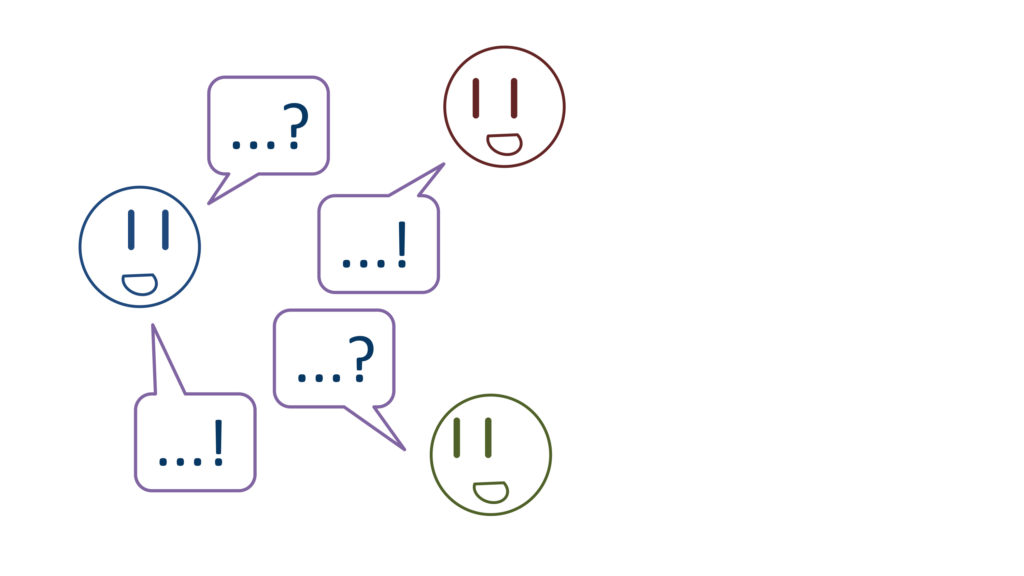
Q: Vincent, are these 8 arenas of conflict, like, THE 8 arenas of conflict?
A: Not at all! Nothing of the sort!
When you design your game, you choose the arenas of conflict your game includes.
In fact, you choose whether you’ll design your game on this model of conflict at all, or on some other model altogether. But even if you do choose to design your game on this model of conflict, you still get to choose which arenas of conflict your game includes, which it excludes, and how it uses its moves to create them.
Q: Vincent, are you talking about genre again? I should choose the arenas of conflict that suit my game’s genre?
A: I guess so!
But it’s worth pointing out that Apocalypse World’s arenas of conflict – honest negotiation, negotiation in bad faith, implicit violence, nonviolent physical striving, explicit threats of violence, etc – there’s nothing post-apocalyptic about them. They represent a super-genre, or a narrative structure not a genre of elements. They’re the arenas of conflict of a blood-and-guts ensemble drama-thriller, or something. I dunno.
But yeah, choose the arenas of conflict that suit your game’s genre, you won’t go wrong.
Q: Vincent, it seems like, up to a point, a different set of basic moves could still apply to these same 8 arenas of conflict. Is this true?
A: Absolutely!
This has happened a lot with those PbtA games so far that’ve stayed close to Apocalypse World. Since the arenas of conflict in Apocalypse World are pretty generally applicable, you might find that they work perfectly for your own game. In that case, you can adapt Apocalypse World’s basic moves just to fit your own vision, without changing the arenas of conflict they represent.
Right on.
Permissions & Expectations Again
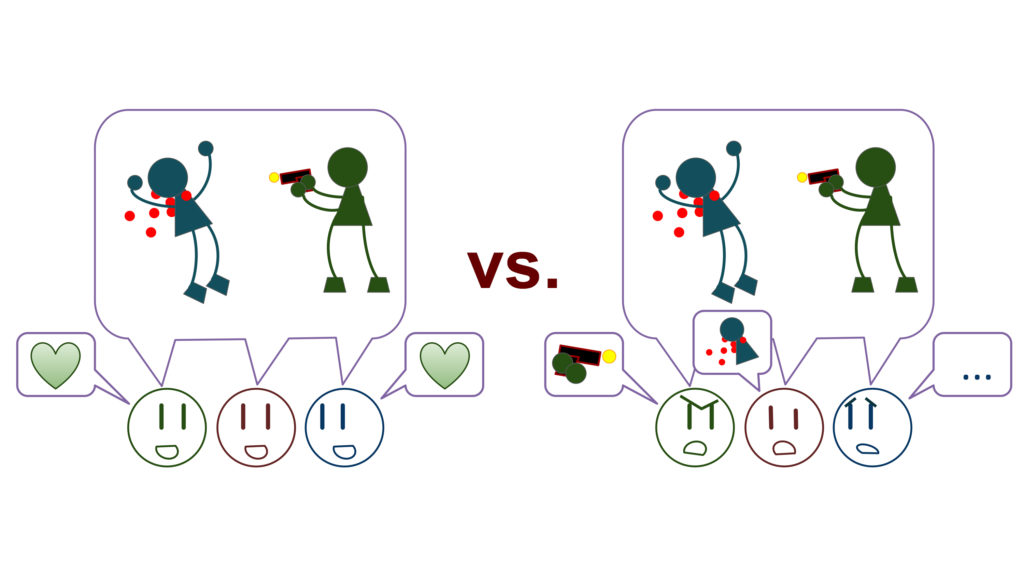
Before I move on from Apocalypse World’s basic moves, let me go back for just a minute to permissions & expectations, to tie the bow.
Apocalypse World’s designed to heighten and escalate the conflicts between the characters, while avoiding or peacefully resolving any conflicts that might develop between us as players. In other words, it’s designed so that we keep collaborating enthusiastically together as players, even when our characters are at odds. In fact, even when they’re locked into intense, bloody, escalating conflicts with each other.
You can think of it as fight choreography. Our characters are in conflict, fighting on opposite sides, but you and I, we’re on the same side, working together to choreograph their fight.
In Apocalypse World, all of the systems are designed to work together to make this happen, and each system approaches it in its own way. The foundation of them all, the basic moves too, is this single principle:
When your character escalates a conflict, you give the other player the choice. When somebody else escalates a conflict against your character, they give you the choice.
You won’t be able to unsee it!
And remember…

Thanks for reading!
Past Installments:
- Back in Part 1, I laid out Apocalypse World’s philosophy and foundation, described the fit and purpose of its systems, and talked about which features are central to its workings and which aren’t.
- Then in Part 2, I walked through the beginnings of taking Apocalypse World’s parts and using them as the basis for a whole new game.
Next Installments:
- In Part 4, I talk about playbooks, by request. What are they, do you want them in your game, and what are the alternatives?
- In Part 5, I take a quick aside to talk about some different ways that moves can fit into the conversation of play.
- In Part 6, I use an Ursula K. LeGuin quote — you probably already know the one — as an outline for alternative models to Apocalypse World’s model of conflict.
- Part 7’s a good old-fashioned Q&A, in rounds: Round 1, Round 2, Round 3 (the lightning round!), & Q&A Round 4 (the Final Round!)
- In Part 8, I share my six best, most reliable tricks for drafting interesting moves.
- In Part 9, I lay some groundwork for the idea of underlying models by pointing out a crucial feature of Apocalypse World.
- In Part 10, I develop the idea of underlying models further, with 2 solid examples and 1 tentative one.
- In Part 11, I explore a few of the dice systems we’ve used in our PbtA games.
- In Part 12, I point out a detail in Apocalypse World’s playbook moves that you might have missed.

Andy says:
Eagerly awaiting the next installment!
Nic says:
Please Vincent, don’t keep us all waiting. It’s been over a month! Awesome series of posts.
Sam says:
New thought about PbtA and Apocalypse World from a PbtA game I’ve been working on:
In Apocalypse World, most characters end up with spheres of responsibility that don’t perfectly correspond to their stats. So yeah, dealing with your gang as a Chopper will often involve rolling Hard (and that’s good and fun), but not always, right? Sometimes it seems like the right answer is to try to Seduce or Manipulate one of them, so that’s what you do, even if your Hot isn’t so hot.
In a lot of RPGs with stats and broadly cooperative parties, no one really has explicit spheres of responsibility, and in practice this means that their responsibility is basically contingent on their stats. Magic thing? The wizard is the one who’s going to roll. Bust down the door? The guy with the highest strength steps up. And the result is that the majority of the rolls you all end up making are all rolls with a high bonus, the experience feels kind of uniform, the balance of target numbers gets wonky (either you balance around this assumption and screw over people on the rare occasion when they try things they don’t have a high stat in, or the reverse), and you never really see any characters’ weaknesses – they’re just implicit from the things you *don’t* see them do (which also means you never get to see someone succeed despite a weakness!). A lot of the time, it feels like everyone is “playing the party” more than playing a character in the party, and it can make quarterbacking problems even worse.
Apocalypse World was one of the first games I played with a cooperative party of characters and character stats where people were routinely rolling moves they had low modifiers for – and without too much metagame strong-arming – maybe the stat was highlighted, but most of the time people were rolling not for the XP, but because it just seemed obvious that they were the one who should be rolling, even if someone with a higher stat could theoretically have dealt with it.
Looking back, this is something that I see really distinguishing a lot of the more and less successful PbtA games. A lot of the PbtA games I’ve enjoyed the most are ones where players have these additional spheres of responsibility, like gangs or holdings or cults or cars in Apocalypse World, that are imperfectly coupled with particular stats – they’re associated with a stat, so the player doesn’t feel screwed over, but they also sometimes call for using other stats, even if that other stat is low, even if someone else in the group could theoretically make the roll more easily.
Vincent Baker says:
This is a fantastic point!
Vian says:
Hi! Loving this series! Above, you wrote: “When your character escalates a conflict, you give the other player the choice. When somebody else escalates a conflict against your character, they give you the choice.” What choice is being given? Is it the choice about what to do next? I don’t understand how that applies to this situation you’re posing, where one character has inflicted harm on another character. What is “the choice” and how does it preserve harmony between the players?
Vincent Baker says:
Good question! I’m adding it to the upcoming Q&A.
João Talassa says:
What do you think are the arena of conflicts for sword & sorcery? How they might differ from those from Apocalypse World or Poison’d?
Vincent Baker says:
Good question! I’m adding it to the Q&A. Thanks!
Powered by the Apocalypse, Part 7: Q&A Round 1 – lumpley games says:
[…] João Talassa […]
Powered by the Apocalypse, Part 7: Q&A Round 2 – lumpley games says:
[…] Vian […]
Marcus says:
Hello, thanks for the breakdown. I wanted to ask:
I understand how moves clarify conflicts, or resolve conflicts. But how do you write a move so it escalates conflict?
Rollenspiel mit Drama Queens - Plotbunny Games says:
[…] Baker erklärt die implizite Konsensmechanik darin im Abschnitt „Permissions & Expectations Again“ und führt sie in der dritten Frage in diesem Blogpost so näher aus (aus den beiden Posts stammt […]